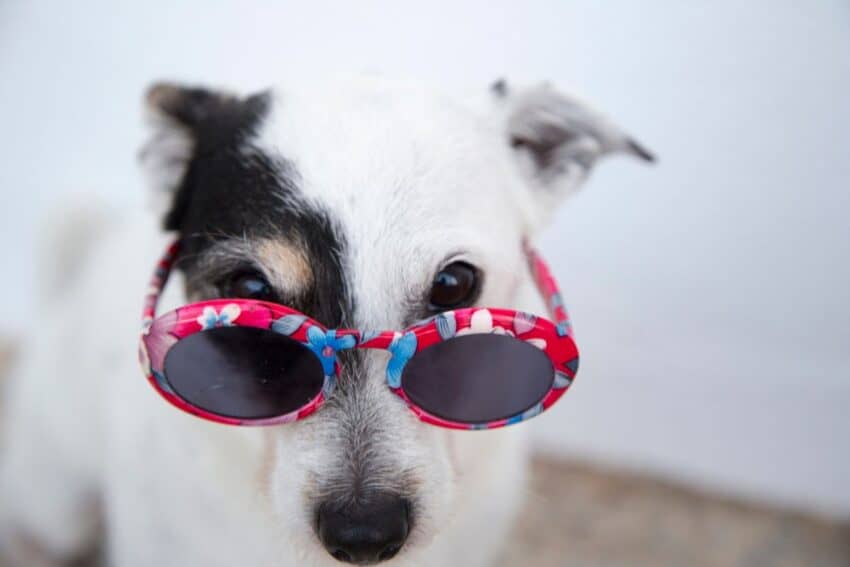Have you ever wondered what colors your dog can see? At some point, we have all heard the fact that dogs are colorblind, but what does that mean? It is a very popular misconception that dogs don’t see color at all, but this is simply not true! While they don’t see the range of colors we do, they do see some colors. So what colors can dogs see? Let’s take a look.

Are dogs colorblind?
Technically, yes, dogs are colorblind. However, this doesn’t necessarily mean that they don’t see any color. While there are some mammals that only see one color, such as the seal or sea lion, dogs aren’t one of them. The word “colorblind” just means that they don’t see all of the colors that we do and that they can get colors more easily mixed up.
Fun fact, humans are technically colorblind too! There are a bunch of animals that see more colors than us. The Mantis shrimp, for example, is able to see the most colors of any animal on the planet, as far as we currently know.
What colors can dogs see?
In the past, scientists believed that dogs only saw black and white, but research conducted by Jay Neitz et al in 1989 found that dogs can actually see yellow and blue, as well as black and white.
The experiment, done with the University of California in Santa Barbara, taught some dogs to pick the odd one out of some colored circles. They were able to distinguish the yellow and blue circles, but not the red or green ones. This suggests that green, red, and similar colors like orange appear as different shades of yellow to dogs, while they perceive blue and yellow in the same way as we do.
How well do dogs see color?
More recent research published in the Proceedings of the Royal Society B in 2013 concluded that dogs are actually pretty good at differentiating between colors and shades. So, not only can they see blue and yellow, but they can distinguish between variations of color, too.
The Russian study involved eight dogs. The dogs were trained to associate different treats with pieces of paper that were colored in various shades of blue and yellow. They found that, more often than not, the dogs could identify the treats correctly.
This means that whilst dogs may not see the full spectrum of colors that humans do, they can see differentiation in shades of color, which would explain why they often like playing with multicolored toys.
However, because they may see many things in similar colors, it could be a little difficult for them to differentiate between objects in certain situations. For example, playing fetch with a green ball on grass.
Why are dogs colorblind?
All animals’ eyes have photoreceptors in their retinas, which are located at the back of the eye. Photoreceptors detect color frequencies of light which allow us to experience color. How much color an animal sees is dependent on how many receptor cones they have.
While humans have three, dogs only have two, which is how we know that they aren’t able to see as many colors as we do.

How else does dog vision compare to ours?
As we all know, smell is a dog’s superior sense, but how good is their vision generally – and how does it compare to ours? Typically, it is thought that the average dog has 20/75 vision. The perfect human vision is known as 20/20, which means you can see an object clearly from 20 feet away.
This means that the average dog must be roughly 20 feet from something to see it as well as a human would standing 75 feet away. That said, certain breeds have better vision than others. Labradors, for example, are commonly used as seeing-eye dogs or guide dogs and have a vision quality that is closer to 20/20.
So, when comes to color and clarity, humans have better eyesight than dogs, they are also about half as visually sensitive to changes in brightness as we are. However, dogs have a much wider peripheral vision than we do because of the shape and placement of their eyes and their narrow skulls, as well as far better night vision.
The average human has a peripheral vision of around 190 degrees, whereas dogs have a peripheral vision of around 250. They also have more rods in their eyes and an extra layer of tissue called the tapetum lucidum, which reflects light into the retina. This is what gives them such great night vision. It’s also what makes their eyes glow in the dark!
What color toys should I buy my dog?
Dogs can enjoy toys of all colors. The most important thing is that your dog has toys of all kinds that they love and enjoy, such as active toys, interactive toys, and chew toys, as well as puzzle toys and comfort toys. That said, blue is most likely the color that stands out most to your dog
The general consensus is that dogs can only see blue and yellow. While they are not completely colorblind, their perception of color is limited in comparison to ours, but that doesn’t mean they enjoy the world around them any less!
What are your thoughts on the colors dogs can see? Share below!


